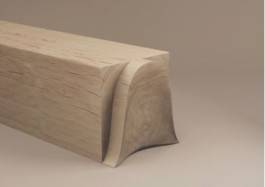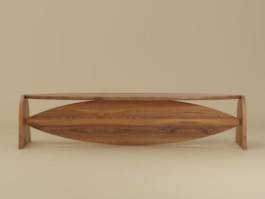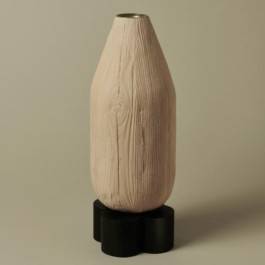



Thibault Huguet, Equarri Bench. (2021) © Thibault Huguet
COLLECTIBLE In-Depth
July 2022
This new series, COLLECTIBLE In-Depth, unveil the backstage of contemporary creation. Tackling various topics from personal designer processes to the position of collectible design on the global design market; these COLLECTIBLE In-Depth offer different views to suit all tastes. Today we talk with Thibault Huguet.
COLLECTIBLE: Can you talk about a book you recently read that inspires you?
Thibault Huguet: "The Stones of the Abbey" (Les Pierres Sauvages - fr),from 1964 by Fernand Pouillon, a famous French modernist architect who rebuilt the district of the old port of Marseille. I reread this book quite often, it is very rich in details. It talks about the monks' construction of Thoronet Abbey in the south of France. F. Pouillon shows us how they achieved this perfect architecture with poor quality stones with determination and devotion. The Thoronet Abbey inspired several architects such as Le Corbusier and John Pawson, who actually wrote "Les Leçons du Thoronet" in 2006 (lessons from Le Thoronet).
C: Can you talk about a place you recently visited that inspires you?
Thibault Huguet: I recently visited the Villa Cavrois at Croix near Roubaix, created by Robert Mallet-Stevens. His work is very inspiring. I like the design of volumes and how he thought about the circulation between spaces. Every detail is perfectly drawn.
C: How did you get into collectible design? Why did you focus your practice on this type of design rather than industrial design?
Thibault Huguet: I learned design in an industrial design school in the Centre of France. I think this disciplined approach is essential because industrial design is a way of thinking. It makes it possible to think about the design and construction of objects in a more well-thought out way. This is the origin of my creations. Collectible design allowed me to meet artisans with incredible know-how and to use high-end materials. You can not really compare industrial design and collectible design. They have two different purposes and functions. However, I find the approach of each project, using design thinking, to be the same.
C: What are the key questions you ask yourself before starting to conceptualize a new piece?
Thibault Huguet: I draw intuitively, objects born from a synthesis of my inspirations. The drawing revolves around a concept or a construction detail, and sometimes from know-how. However, I don’t find the creative process to be instinctive. Instead, I start from an idea, and I draw and redraw again and again to find the right shape. When I draw an object, I constantly think about how it could be made, taking into account potential technical constraints. I also pay particular attention to its different viewpoints since I like that the shape of my objects significantly changes or reveals assembly details when viewed from different angles.

Thibault Huguet , Zeppelin. (2021) © Thibault Huguet

Thibault Huguet, Lusus Naturae. (2021) © Thibault Huguet
About Thibault Huguet
Thibault Huguet was born in 1989 in the Massif Central in France. After training as an industrial designer, he collaborated for six years with renowned agencies. In 2020, he created his studio in Paris. Now based in Brussels, he continues collaborating with major brands and architecture studios.
At the same time, he offers his own creations made in collaboration with French craftsmen. He draws his inspiration from various fields such as shipbuilding and aeronautics, or sometimes far from design such as archeology. His creations combine craftsmanship and industrial design constraints, which intertwine and enrich each other to create a singular production. He pays particular attention to detail and design of its objects.
COLLECTIBLE In-Depth
July 2022

Thibault Huguet, Equarri Bench. (2021) © Thibault Huguet
This new series, COLLECTIBLE In-Depth, unveil the backstage of contemporary creation. Tackling various topics from personal designer processes to the position of collectible design on the global design market; these COLLECTIBLE In-Depth offer different views to suit all tastes. Today we talk with Thibault Huguet.
COLLECTIBLE: Can you talk about a book you recently read that inspires you?
Thibault Huguet: "The Stones of the Abbey" (Les Pierres Sauvages - fr),from 1964 by Fernand Pouillon, a famous French modernist architect who rebuilt the district of the old port of Marseille. I reread this book quite often, it is very rich in details. It talks about the monks' construction of Thoronet Abbey in the south of France. F. Pouillon shows us how they achieved this perfect architecture with poor quality stones with determination and devotion. The Thoronet Abbey inspired several architects such as Le Corbusier and John Pawson, who actually wrote "Les Leçons du Thoronet" in 2006 (lessons from Le Thoronet).
C: Can you talk about a place you recently visited that inspires you?
Thibault Huguet: I recently visited the Villa Cavrois at Croix near Roubaix, created by Robert Mallet-Stevens. His work is very inspiring. I like the design of volumes and how he thought about the circulation between spaces. Every detail is perfectly drawn.
C: How did you get into collectible design? Why did you focus your practice on this type of design rather than industrial design?
Thibault Huguet: I learned design in an industrial design school in the Centre of France. I think this disciplined approach is essential because industrial design is a way of thinking. It makes it possible to think about the design and construction of objects in a more well-thought out way. This is the origin of my creations. Collectible design allowed me to meet artisans with incredible know-how and to use high-end materials. You can not really compare industrial design and collectible design. They have two different purposes and functions. However, I find the approach of each project, using design thinking, to be the same.
C: What are the key questions you ask yourself before starting to conceptualize a new piece?
Thibault Huguet: I draw intuitively, objects born from a synthesis of my inspirations. The drawing revolves around a concept or a construction detail, and sometimes from know-how. However, I don’t find the creative process to be instinctive. Instead, I start from an idea, and I draw and redraw again and again to find the right shape. When I draw an object, I constantly think about how it could be made, taking into account potential technical constraints. I also pay particular attention to its different viewpoints since I like that the shape of my objects significantly changes or reveals assembly details when viewed from different angles.

Thibault Huguet , Zeppelin. (2021) © Thibault Huguet

Thibault Huguet, Lusus Naturae. (2021) © Thibault Huguet
About Thibault Huguet
Thibault Huguet was born in 1989 in the Massif Central in France. After training as an industrial designer, he collaborated for six years with renowned agencies. In 2020, he created his studio in Paris. Now based in Brussels, he continues collaborating with major brands and architecture studios.
At the same time, he offers his own creations made in collaboration with French craftsmen. He draws his inspiration from various fields such as shipbuilding and aeronautics, or sometimes far from design such as archeology. His creations combine craftsmanship and industrial design constraints, which intertwine and enrich each other to create a singular production. He pays particular attention to detail and design of its objects.
Contact
info@collectible.design
VIP PORTAL
EXHIBITOR PORTAL
PRIVACY POLICY
© 2025 Collectible
Contact
info@collectible.design
VIP PORTAL
EXHIBITOR PORTAL
PRIVACY POLICY
© 2025 Collectible